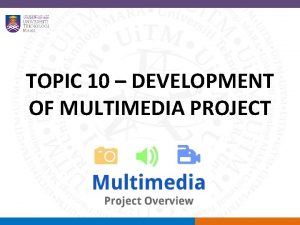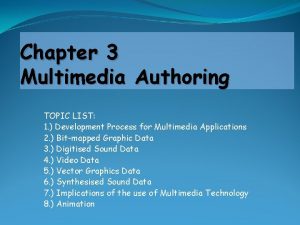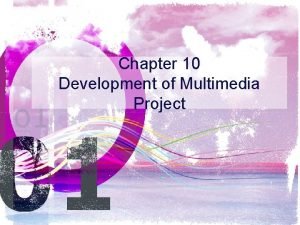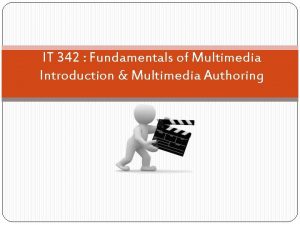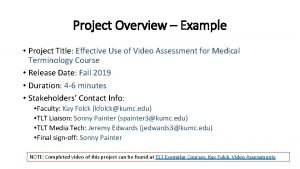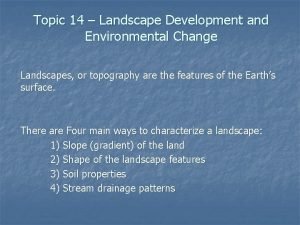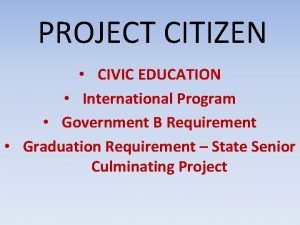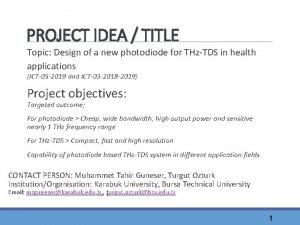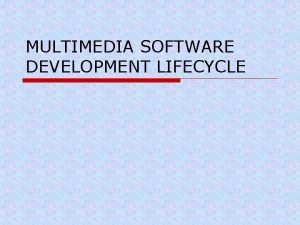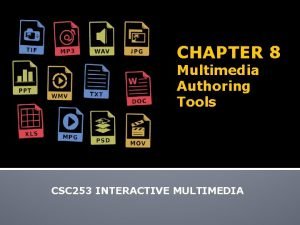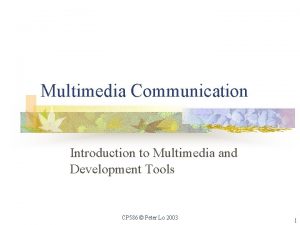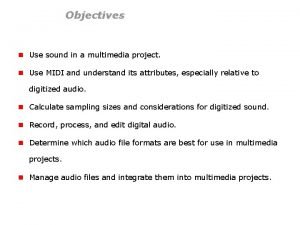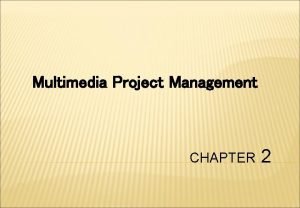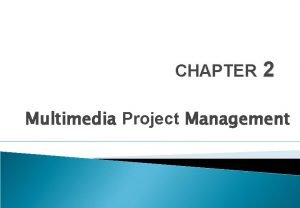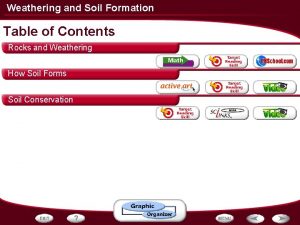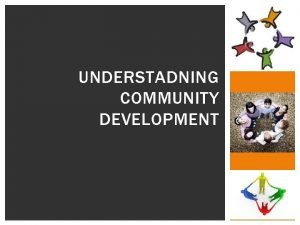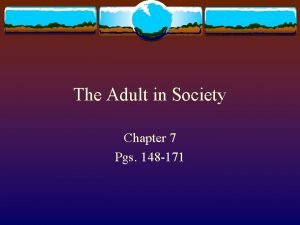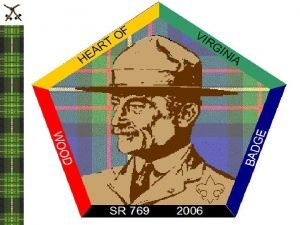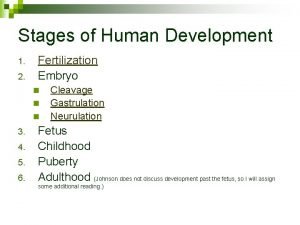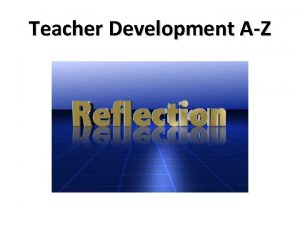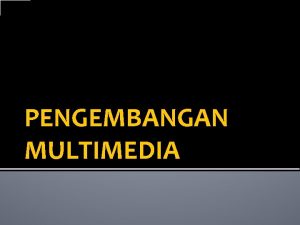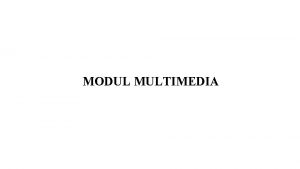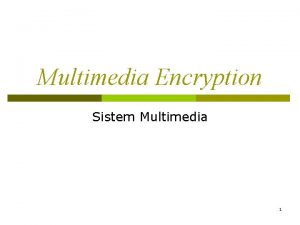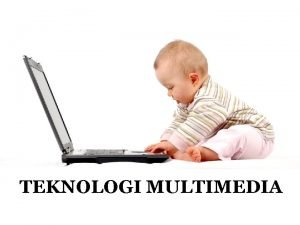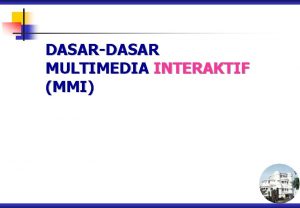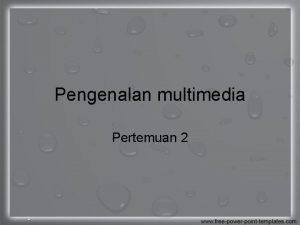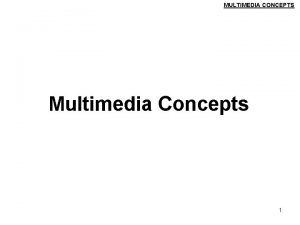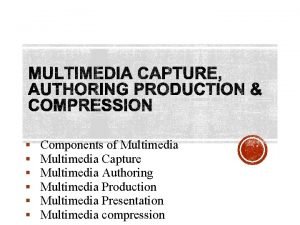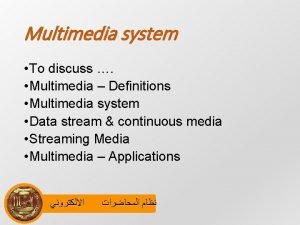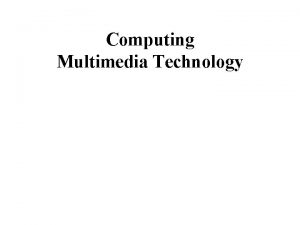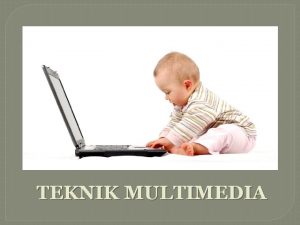TOPIC 10 DEVELOPMENT OF MULTIMEDIA PROJECT Overview Stages




























![Roles and Responsibilities in a Multimedia Team [1] • The project manager is responsible Roles and Responsibilities in a Multimedia Team [1] • The project manager is responsible](https://slidetodoc.com/presentation_image_h/8a40af52f333887e461c12b906c32c3b/image-29.jpg)
![Roles and Responsibilities in a Multimedia Team [2] • Multimedia designer – This team Roles and Responsibilities in a Multimedia Team [2] • Multimedia designer – This team](https://slidetodoc.com/presentation_image_h/8a40af52f333887e461c12b906c32c3b/image-30.jpg)
![Roles and Responsibilities in a Multimedia Team [2] • Multimedia designer – This team Roles and Responsibilities in a Multimedia Team [2] • Multimedia designer – This team](https://slidetodoc.com/presentation_image_h/8a40af52f333887e461c12b906c32c3b/image-31.jpg)
![Roles and Responsibilities in a Multimedia Team [3] • An interface designer is responsible Roles and Responsibilities in a Multimedia Team [3] • An interface designer is responsible](https://slidetodoc.com/presentation_image_h/8a40af52f333887e461c12b906c32c3b/image-32.jpg)
![Roles and Responsibilities in a Multimedia Team [4] A multimedia writer is responsible for: Roles and Responsibilities in a Multimedia Team [4] A multimedia writer is responsible for:](https://slidetodoc.com/presentation_image_h/8a40af52f333887e461c12b906c32c3b/image-33.jpg)
![Roles and Responsibilities in a Multimedia Team [5] A video specialist needs to understand: Roles and Responsibilities in a Multimedia Team [5] A video specialist needs to understand:](https://slidetodoc.com/presentation_image_h/8a40af52f333887e461c12b906c32c3b/image-34.jpg)
![Roles and Responsibilities in a Multimedia Team [6] An audio specialist is responsible for: Roles and Responsibilities in a Multimedia Team [6] An audio specialist is responsible for:](https://slidetodoc.com/presentation_image_h/8a40af52f333887e461c12b906c32c3b/image-35.jpg)
![Roles and Responsibilities in a Multimedia Team [7] Multimedia programmer, also called a software Roles and Responsibilities in a Multimedia Team [7] Multimedia programmer, also called a software](https://slidetodoc.com/presentation_image_h/8a40af52f333887e461c12b906c32c3b/image-36.jpg)
![Roles and Responsibilities in a Multimedia Team [8] Multimedia producer for the Web: – Roles and Responsibilities in a Multimedia Team [8] Multimedia producer for the Web: –](https://slidetodoc.com/presentation_image_h/8a40af52f333887e461c12b906c32c3b/image-37.jpg)


- Slides: 39

TOPIC 10 – DEVELOPMENT OF MULTIMEDIA PROJECT

Overview • Stages of a multimedia project. • Requirements for a multimedia project. • The team 2

Stages of a Multimedia Project 1 • Planning and costing 2 • Design and production 3 • Testing 4 • Delivery 3

Stages of a Multimedia Project 1. Planning and costing: – The needs of a project are analyzed by outlining its messages and objectives. – A plan that outlines the required multimedia expertise is prepared 4

Stages of a Multimedia Project 1. Planning and costing (continued): – A graphic template, the structure, and navigational system are developed. – A time estimate and a budget are prepared. – A short prototype or proof-of-concept is prepared. 5

Stages of a Multimedia Project 2. Design and production: – The planned tasks are performed to create a finished product. – The product is revised, based on the continuous feedback received from the client. 6

Stages of a Multimedia Project • 3. Testing - The program is tested to ensure that it meets the objectives of the project, works on the proposed delivery platforms, and meets the client requirements. • 4. Delivery - The final project is packaged and delivered to the end user. 7

The Process of Making Multimedia 1. Idea analysis 2. Pre-testing 3. Task planning 4. Development 5. Delivery 8

The Process of Making Multimedia (continued) • Idea analysis – Before beginning a multimedia project, it is necessary to determine its scope and content. – Balance is the key principle in idea analysis. – The aim is to generate a plan of action that will become the road map for production. 9

The Process of Making Multimedia (continued) • Idea analysis (continued) – It is necessary to continually weigh the purpose or goal against the feasibility and the cost of production and delivery. – This can be done dynamically by adding elements to or subtracting elements from a project. 10

The Process of Making Multimedia (continued) • Idea analysis (continued) – CPM - Project management software typically provides Critical Path Method (CPM) scheduling functions to calculate the total duration of a project based upon each identified task, showing prerequisites. – PERT - Program Evaluation Review Technique (PERT) charts provide graphic representations of task relationships. – Gantt charts - depict all the tasks along a timeline. 11

12

13

The Process of Making Multimedia (continued) • Pre-testing – Define your project goals in fine detail and spelling out what it will take in terms of skills, content, and money to meet these goals. – Work up a prototype of the project on paper to help you relate your ideas to the real world. 14

The Process of Making Multimedia (continued) • Task planning involves: – Designing the instructional framework. – Holding creative idea sessions. – Determining the delivery platform and authoring platform. – Assembling the team. – Building a prototype, producing audio and video, testing the functionality, and delivering the final product. 15

The Process of Making Multimedia (continued) 16

The Process of Making Multimedia (continued) • Prototype development: – Also known as a proof-of-concept or feasibility study. – Involves testing of the initial implementation of ideas, building mock-up interfaces, and exercising the hardware platform. – Trial calculations are possible after prototyping. 17

The Process of Making Multimedia (continued) • Alpha development – At this stage, the investment of effort increases and becomes more focused. More people get involved. • Beta development – At this stage, most of the features of a project are functional. Testing is done by a wider arena of testers. 18

The Process of Making Multimedia (continued) • Delivery – In the delivery stage, the project is said to be “going gold. ” – The concerns shift towards the scalability of the project in the marketplace. 19

Requirements for a Multimedia Project • Hardware. • Software. • Creativity and organizational skills. 20

Hardware • The most significant platforms for producing and delivering multimedia projects are Macintosh operating system and Microsoft Windows. • These systems provide an easy-to-use graphical user interface (GUI). 21

Hardware • The Macintosh as well as Windows PC offers a combination of affordability, and software and hardware availability. • The Macintosh platform is better suited for multimedia production than the Windows platform. • The hardware platforms provided by Apple are better equipped to manage both, sound and video editing. 22

Macintosh & Windows Platform 23

Software • Multimedia software provides specific instructions to the hardware for performing tasks. • Software tools are divided into production tools and authoring tools. 24

Creativity and Organizational Skills • In a multimedia project, being creative implies knowledge of hardware and software. • It is essential to develop an organized outline detailing the skills, time, budget, tools and resources needed for the project. 25

Creativity and Organizational Skills • Assets such as graphics, sound and the like should be continuously monitored throughout the project’s execution. • A standardized file-naming procedure should be followed for precise organization and swift retrieval. 26

Members of a Multimedia Team • A team of skilled individuals is required to create a good multimedia project. • Team building refers to activities that help a group and its members function at optimum levels. • The diverse range of skills required for a project is called the multimedia skillset. 27

Members of a Multimedia Team A multimedia team consists of the following: 1. Project manager. 2. Multimedia designer. 3. Interface designer. 4. Writer. 5. Video specialist. 6. Audio specialist. 7. Multimedia programmer. 8. Producer for the Web. 9. Computer programmers. 28
![Roles and Responsibilities in a Multimedia Team 1 The project manager is responsible Roles and Responsibilities in a Multimedia Team [1] • The project manager is responsible](https://slidetodoc.com/presentation_image_h/8a40af52f333887e461c12b906c32c3b/image-29.jpg)
Roles and Responsibilities in a Multimedia Team [1] • The project manager is responsible for: – The overall development, implementation, and day-to-day operations of the project – The design and management of a project – Understanding the strengths and limitations of hardware and software – Ensuring people skills and organizational skills – Conveying information between the team and the client 29
![Roles and Responsibilities in a Multimedia Team 2 Multimedia designer This team Roles and Responsibilities in a Multimedia Team [2] • Multimedia designer – This team](https://slidetodoc.com/presentation_image_h/8a40af52f333887e461c12b906c32c3b/image-30.jpg)
Roles and Responsibilities in a Multimedia Team [2] • Multimedia designer – This team consists of: – Graphics designers, illustrators, animators, and image processing specialists who deal with visuals, thereby making the project appealing and aesthetic – Instructional designers, who make sure that the subject matter is presented clearly for the target audience 30
![Roles and Responsibilities in a Multimedia Team 2 Multimedia designer This team Roles and Responsibilities in a Multimedia Team [2] • Multimedia designer – This team](https://slidetodoc.com/presentation_image_h/8a40af52f333887e461c12b906c32c3b/image-31.jpg)
Roles and Responsibilities in a Multimedia Team [2] • Multimedia designer – This team consists of: – Interface designers, who devise the navigational pathways and content maps – Information designers, who structure content, determine user pathways and feedback, and select presentation media 31
![Roles and Responsibilities in a Multimedia Team 3 An interface designer is responsible Roles and Responsibilities in a Multimedia Team [3] • An interface designer is responsible](https://slidetodoc.com/presentation_image_h/8a40af52f333887e461c12b906c32c3b/image-32.jpg)
Roles and Responsibilities in a Multimedia Team [3] • An interface designer is responsible for: – Creating a software device that organizes content, allows users to access or modify content, and presents that content on the screen – Building a user-friendly interface 32
![Roles and Responsibilities in a Multimedia Team 4 A multimedia writer is responsible for Roles and Responsibilities in a Multimedia Team [4] A multimedia writer is responsible for:](https://slidetodoc.com/presentation_image_h/8a40af52f333887e461c12b906c32c3b/image-33.jpg)
Roles and Responsibilities in a Multimedia Team [4] A multimedia writer is responsible for: – Creating characters, actions, point of view, and interactivity. – Writing proposals and test screens. – Scripting voice-overs and actors' narrations. 33
![Roles and Responsibilities in a Multimedia Team 5 A video specialist needs to understand Roles and Responsibilities in a Multimedia Team [5] A video specialist needs to understand:](https://slidetodoc.com/presentation_image_h/8a40af52f333887e461c12b906c32c3b/image-34.jpg)
Roles and Responsibilities in a Multimedia Team [5] A video specialist needs to understand: – The delivery of video files on CD, DVD, or the Web. – How to shoot quality video. – How to transfer the video footage to a computer. – How to edit the footage down to a final product using digital nonlinear editing system (NLE). 34
![Roles and Responsibilities in a Multimedia Team 6 An audio specialist is responsible for Roles and Responsibilities in a Multimedia Team [6] An audio specialist is responsible for:](https://slidetodoc.com/presentation_image_h/8a40af52f333887e461c12b906c32c3b/image-35.jpg)
Roles and Responsibilities in a Multimedia Team [6] An audio specialist is responsible for: – Locating and selecting suitable music talent. – Scheduling recording sessions. – Digitizing and editing recorded material into computer files. 35
![Roles and Responsibilities in a Multimedia Team 7 Multimedia programmer also called a software Roles and Responsibilities in a Multimedia Team [7] Multimedia programmer, also called a software](https://slidetodoc.com/presentation_image_h/8a40af52f333887e461c12b906c32c3b/image-36.jpg)
Roles and Responsibilities in a Multimedia Team [7] Multimedia programmer, also called a software engineer: – Integrates all the multimedia elements into a seamless project, using authoring systems or programming language. – Writes codes for the display of multimedia elements, and to control various peripheral devices. – Manages timings, transitions, and record keeping. 36
![Roles and Responsibilities in a Multimedia Team 8 Multimedia producer for the Web Roles and Responsibilities in a Multimedia Team [8] Multimedia producer for the Web: –](https://slidetodoc.com/presentation_image_h/8a40af52f333887e461c12b906c32c3b/image-37.jpg)
Roles and Responsibilities in a Multimedia Team [8] Multimedia producer for the Web: – Web site producers put together a coordinated set of pages for the Web. – They also co-ordinate updates and changes. 37

Summary • The basic stages of a multimedia project are planning and costing, design and production, testing and delivery. • Knowledge of hardware and software, as well as creativity and organizational skills are essential for creating a high-quality multimedia project. 38

Summary • The diverse skills required to create a multimedia project is called the multimedia skillset. • Team building refers to activities that help a group and its members function at optimum levels of performance. • Roles and responsibilities are assigned to each team member in a multimedia project. 39
 Different stages of multimedia project
Different stages of multimedia project Stages of multimedia application development
Stages of multimedia application development Planning and costing in multimedia
Planning and costing in multimedia Overview of multimedia software tools
Overview of multimedia software tools Examples of clincher sentences
Examples of clincher sentences Topic down
Topic down Multimedia becomes interactive multimedia when
Multimedia becomes interactive multimedia when Examples of linear multimedia
Examples of linear multimedia Multimedia becomes interactive multimedia when
Multimedia becomes interactive multimedia when Esa multimedia.esa.int./multimedia/virtual-tour-iss
Esa multimedia.esa.int./multimedia/virtual-tour-iss What is project overview example
What is project overview example Sap project system overview
Sap project system overview Management topics for project
Management topics for project Landscape development and environmental changes
Landscape development and environmental changes Project citizen topic ideas
Project citizen topic ideas Multigenre research project examples
Multigenre research project examples Project topic on social studies
Project topic on social studies Topic design for project
Topic design for project Multimedia software development
Multimedia software development Advantages of icon based authoring tool
Advantages of icon based authoring tool History of multimedia development
History of multimedia development Adding sound to multimedia project
Adding sound to multimedia project Multimedia project management
Multimedia project management Multimedia project definition
Multimedia project definition Spiracle slits of a blowfly larva
Spiracle slits of a blowfly larva Hilda taba model of curriculum development
Hilda taba model of curriculum development Stages of river development
Stages of river development 5 factors of soil formation
5 factors of soil formation Stages of human growth and development pictures
Stages of human growth and development pictures Uncontrolled scribbling
Uncontrolled scribbling Five stages of community development process
Five stages of community development process Zealous
Zealous Levinson stages of development
Levinson stages of development Levinson stages of development
Levinson stages of development Ts alice toung
Ts alice toung Forming storming norming performing
Forming storming norming performing Animal pole
Animal pole Pre-affiliation
Pre-affiliation Maslow developmental stages
Maslow developmental stages Stages of soil development
Stages of soil development
